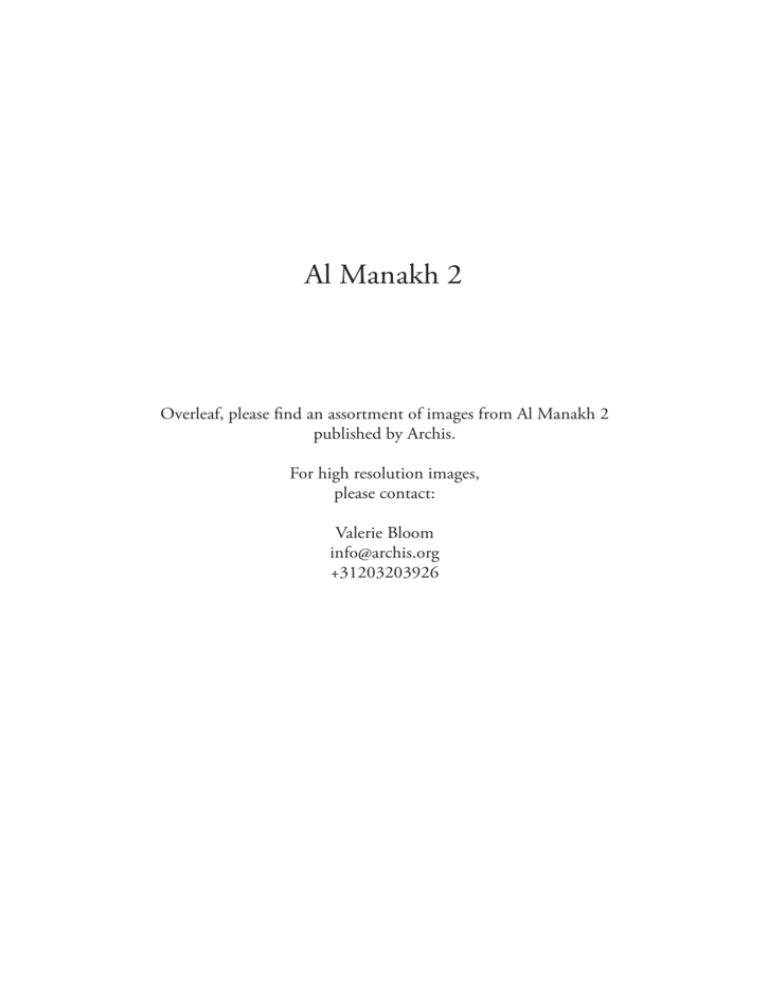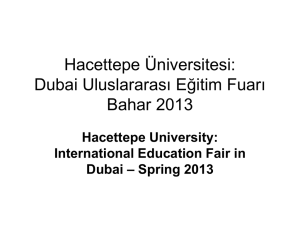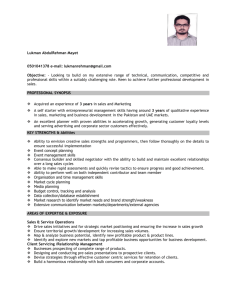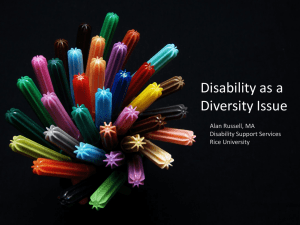Al Manakh 2
advertisement

Al Manakh 2 Overleaf, please find an assortment of images from Al Manakh 2 published by Archis. For high resolution images, please contact: Valerie Bloom info@archis.org +31203203926 113 Billboard for Marmooka City, Ajman. As of July 2009, its 206-tower plan had been scaled back to 20 towers. Photo Todd Reisz 154 West Bay Lagoon Plaza Towers, Doha, March 3, 2009. Photo Mitra Khoubrou 205 The Dubai metro. Photo Katrin Greiling 206 The Dubai metro. Photo Katrin Greiling 208 The Dubai metro. Photo Katrin Greiling 235 Yas Island. Photo Katrin Greiling 259 The preservation of Diriyah. Photo Todd Reisz 263 The Arriyadh Development Authority makes public space in Riyadh. Photo Ar-Riyadh Development Authority 352 Burj Khalifa is Downtown. On January 4, 2010 a structure that had already been an indelible piece of Dubai’s landscape for the last five years was deemed complete. The ribbon-cutting eventwas described by many onlookers as pleasant, not overdone, and by the press as both Dubai’s start to a comeback and the peak of a swan song. In a surprise dedication the ‘burj’ was renamed Burj Khalifa, in honor of Sheikh Khalifa bin Zayed al Nahyan, President of the UAE and Ruler of Abu Dhabi. The naming gave the tower yet another symbolic duty – it signified Dubai’s closer ties with Abu Dhabi. Before the opening of the world’s tallest tower, Souk Bahar and Dubai Mall beat everyone’s expectation, not because Dubai got a Galeries Lafayette, but a muchneeded public space. It might be flooded with an Andrea Bocelli song every hour on the hour to conduct the world’s largest fountain but you’d find it difficult to say it didn’t attract a cross-section of Dubai’s splendid variety of society. Photo Katrin Greiling 367 Bahrain’s rainbow houses. Photo Nicholas Kothari 392 Tea counter in Calicut, India, May 4, 2009. Photo Todd Reisz 392 A Malayali social group in Zalamat Park, Abu Dhabi, December 18, 2009. Photo Katrin Greiling 400 Western Union Kamp Ka Champ is a three-year-old event sometimes referred to as ‘Dubai Idols’. Western Union (whose yellowness drapes everything) is the main sponsor of the event, supported by contracting and security companies who house significant numbers of employees in Dubai’s so-called labor accommodations. The singing/Bollywood-trivia contest spans over days of auditions when hundreds compete to make it to the semifinals. The early rounds bring the streets and courtyards of sponsoring labor accommodations alive with music and cheer. Those making it to the finals head to Dubai’s historic Al Nasr Leisureland for a grand stage watched by invited friends and sponsors’ guests. Pakistanis, Bangladeshis, Sri Lankans and Indians mostly sing Hindi songs to please the majority. A Pakistani chooses a patriotic Pakistan song as the finals fell on Pakistan’s National Day. Between acts, Western Union commercials remind the audience just how easy sending money to families back home can be. And then the music and swaying crowd begin again. The winning duo – with the highest scores from SMS-votes and most correct Bollywood trivia answers – take home 1500 dirhams ($400), a new television, and the fame from being this year’s idols. Photo Katrin Greiling 407 A temporary mosque in Sulaibiya, Kuwait, September 4, 2009. Photo Jasmine Melvin-Koushi 413 A covered courtyard in KAUST’s laboratories, October 18, 2009. Photo Reda Sijny 428 The renovation of Souq Waqif, Doha. Photo Todd Reisz 430 The flattening of Riyadh. Photo Joumana al Jabri 437 The empty quarter. Photo Katrin Greiling 465 Where: Africa To Feed: UK (Private Investment) What: Unspecified In October 2008, the Financial Times reported that Lonrho was putting together funds to acquire 20,000 hectares of farmland in Angola in order to make money from global food trade in a time of high prices. It is part of a wider, ‘aggressive’ strategy to acquire ten times that amount for the same purposes across Africa. The Angola Government is reportedly trying to attract $6 billion worth of new agricultural investment with corporations from Brazil, Spain, Portugal, Argentina, Canada and the US. Where: Africa To Feed: GCC What: $1 billion investment Three Gulf Firms announced the creation of AgriCapital, a new Islamic investment fund in August 2008. The $1 billion investment vehicle will engage in land purchases overseas to produce food for the region through a separate investment bank specially created for this purpose. Where: Ethiopia To Feed: Saudi Arabia What: Investment and development In August 2008, Ethiopia’s Prime Minister told the Financial Times that he is eager to give Saudi investors access to ‘hundreds of thousands’ of hectares of farmland for investment and development. Where: Pakistan To Feed: UAE What: Rice, wheat, dairy Abraaj Capital, together with the UAE Government, acquired 800,000 acres of supposedly ‘barren’ farmland in Pakistan over the last year. Reports are also circling that the Emirates Investment Group and the Abu Dhabi Group are not far behind in seeking similar deals. Overall investment from Abu Dhabi in Pakistani agriculture is said to be worth $3 billion already. Where: Pakistan To Feed: UAE What: Unspecified The UAE Government is in bilateral talks with Pakistan to purchase $400500 million worth of farmland. The deal would involve 100,000-200,000 acres in large holdings in Pakistan’s Punjab and Sindh provinces. Under the deal, the UAE investors would be able to purchase land directly in Pakistan for agribusiness operations or enter into joint ventures with Pakistani farmers. The talks are focused on large holdings in order to keep transport and logistics costs down, and the attraction of joint ventures is to cut out middlemen. The UAE is also requesting to exempt the lands entirely from Pakistan’s export policies. Where: Pakistan To Feed: Qatar What: Rice One Qatari firm is reportedly eyeing the acquisition of Pakistan government’s Kolurkar farm in Punjab to produce food to export to Qatar. The head of Pakistan Farmers Forum says that if the Qataris get the land, it may dislocate 25,000 villagers. Where: Indonesia To Feed: Saudi Arabia What: Rice, grain In August 2008, the Binladen Group signed an agreement to invest at least $4.3 billion, on behalf of a consortium of fifteen Saudi investors to develop 500,000 hectares of rice land in Indonesia. Binladen has been described by some sources as the principal firm ‘tasked’ by the Saudi government to deal with the Kingdom’s long-term food supply problem. With ‘acquisitions’ of land already in the Papua and Sultra provinces, the group has considered reserving some rice for local markets ‘so that the people there don’t cause us problems’. Where: Cambodia To Feed: Qatar What: Rice Qatar sealed a deal to access Khmer farmland for production and export of rice to Doha. In exchange, Cambodia will receive technical assistance as well as an invitation for Hun Sen to visit Qatar in 2009 to make a bit for Cambodia to ‘corner the gulf rice market. Cambodia is hoping to become the world’s top rice exporter by 2015 despite continuing domestic hunger’. Where: Cambodia To Feed: Kuwait What: Rice In August 2008, Kuwait inked a bilateral deal with the Cambodian Government in which Kuwait will receive access to Khmer rice lands to produce rice for export back to Kuwait, with any surplus going to international markets. Cambodia will receive agricultural technologies and a $546 million loan to develop irrigation and road infrastructure in Battambang, Cambodia’s rice-growing province. $O0DQDNKB),1$/LQGG Where: Philippines To Feed: Bahrain What: Rice and livestock In May 2008, Bahrain’s Trade Minister went to The Philippines to secure access to ‘large plots of land’ to grow basmati rice for Bahrain’s consumption. According to some reports, the project aims not only to serve Bahrain’s food security but also provide employment and raise supplies to local communities. Where: Thailand To Feed: Saudi Arabia What: Rice A delegation of Saudi businessmen visited Suphanburi province to explore the potential of leasing land for their own rice production, and rice export joint ventures with local counterparts to supply the Saudi market. Any surplus would be sold to other Gulf nations. Public debate regarding scrutiny of the project revealed unreleased details that Taiwanese and US investors already had bought land in Thailand to grow crops for export abroad. Where: China To Feed: … What: Poultry In 2008, Goldman Sachs invested $300 million to acquire full control of more than ten poultry farms in Hunan and Fujian provinces. Goldman already controls Henan Shuanghui and holds a 13% stake in China Yuran Food Group (China’s top two meat processors). Where: Everywhere To Feed: UAE What: Rice, Livestock, Dairy Al-Qudra Holdings plans to acquire 400,000 hectares of land in Australia, Croatia, Egypt, Eritrea, India, Morocco, Pakistan, Philippines, Sudan, Syria, Thailand, Ukraine and Vietnam. The land is to be acquired through a mixture of 20-30 year leases, concessions and outright purchases. The CEO of Al-Qudra states reported that 40% of the total investment would go to maize crops although no decision has been made about whether to convert it to Ethanol. This investment plan may expand to port operations, breeding, and manufacturing of irrigation equipment. 465 Volume 23 Where: Sudan To Feed: UAE What: Wheat, maize, potatoes The UAE Government is investing in 378,000 hectares of farmland in various Sudanese states. According to some sources, Khartoum is providing the land for free. Where: Pakistan, Sudan, Turkey To Feed: Saudi Arabia What: Rice and wheat In August 2008, The Saudi Fund for Development announced that it will set up a $566 million special investment vehicle for buying land abroad for domestic food production. According to the Asian Times, Pakistan has requested $6 million of oil and financial aid in return for access to its farmlands. Food Security Illustration Jonathan Hanahan 501 The Museum of Islamic Art, Doha Photo Todd Reisz




